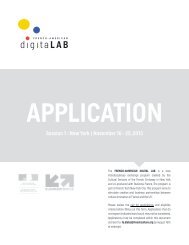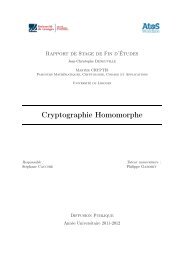REX
BD16_REX
BD16_REX
Create successful ePaper yourself
Turn your PDF publications into a flip-book with our unique Google optimized e-Paper software.
Retours d’expériences Big Data en entreprise<br />
DEFINING REQUIREMENTS<br />
Preparing the way.<br />
In an increasingly aggressive industry, Elsevier required shorter delivery cycles for its competitive offerings. So as<br />
a pioneer in the digital marketplace, they defined the parameters for products that extracted content from authors<br />
fast and put it online even faster. Equally signifi- cant, Elsevier recognized that to give users exactly the information<br />
they wanted, any new solutions must have the power to dynamically assemble relevant information from across<br />
multiple sources. Recognizing the poten- tial of tagged search elements, Elsevier started in the year 2000 to redesign<br />
products along Web services architecture.<br />
Beginning with Standard Generalized Markup Language (SGML), Elsevier moved forward, keeping pace with the<br />
evolution of descriptive signature technologies and ultimately investing in the benefits of XML (Extensible Markup<br />
Language). Of course, such advances helped deliver greater content relevancy to users. But enabling the highest<br />
degree of granularity meant the structural relationships of tagged content had to be leveraged in a way that allowed<br />
relevant information deep within docu- ments to be parsed and reassembled into new content.<br />
Accordingly, the absence of a centralized content repository had to be remedied, since an intelligent terminus<br />
would be required for all searches – enabling the deconstruction and synthesis of documents into con- text- specific<br />
results. This eliminated the deployment of traditional relational database systems, whose concepts and data<br />
models were conceived in an era of short, highly- structured records of data, and not the unpredictable and timevarying<br />
structure found in content.<br />
Instead, the new solution would need to:<br />
• Exploit the wide variety of unstructured content, rather than be constrained by it.<br />
• Eliminate format and content-prejudiced conditions for standardization of information.<br />
• Function without a single, standard, pre-defined schema, and indeed in the presence of many different and<br />
changing schemas<br />
• Achieve performance without sacrificing relevance. Both the user interface and the returned results had to operate<br />
quickly and efficiently, and to deliver the right pieces of information at the right time.<br />
Roadblocks to rapid product development<br />
When developing new products, Elsevier had to confront:<br />
• Difficulty in leveraging and synthesizing information from docu- ments held among a wide range of different databases<br />
and the applications on each.<br />
• Lack of a “content common denominator” for normalizing informa- tion within applications or databases.<br />
• Risk of poor ROI due to long and expensive implementation of new functionality and applications.<br />
• A mountain of disparate content with no existing unifying solution<br />
PUTTING MARK LOGIC TO THE TEST<br />
Transforming a mountain of documents into a single, searchable contentbase.<br />
By the year 2004, Elsevier had reengineered their products along the lines of web service architectures, creating<br />
an XML repository offering new efficiencies to their IT staff and higher functionality for users. But the apron strings<br />
of relational database technology still tied the company down to long, expensive product develop- ment cycles and<br />
less than optimal performance. To get reasonable content performance from their database management systems<br />
they still needed to pre-define schemas and access paths: time-consuming tasks that ultimately limit content ingestion<br />
and the power of resultant searches. And after intensifying their hunt for new ways to shorten time to market<br />
and add greater value to their content they found what looked like a per-fect way to leverage their significant investment<br />
in XML: MarkLogic Server.<br />
“We offered to show Elsevier how the MarkLogic Server could leverage their investment in XML to deliver on Elsevier’s<br />
vision,” recalls Mark Logic Co-founder and Chief Technologist Paul Pedersen. “Our promise was simple.<br />
Hand us any amount of data, as is, from your archives.<br />
We’ll hand you back an entirely new application based on that content.” And as Pedersen further described to<br />
Elsevier, “The system lets you reach across large content sets, extract exactly the information that you need, and<br />
then present it as a new document that was created automatically.”<br />
Intrigued by the prospect of being able to simply pour existing archives and content into MarkLogic Server and<br />
receive a fully functional application, Elsevier agreed to the test. And to see just how short a timeline Mark Logic<br />
could deliver a competitive product in, they made it a demanding one. According to Pedersen, “...Their team<br />
handed us an entire product line of 20 medical textbooks, each a thousand pages long or more. They didn’t even<br />
provide the DTDs,” he recalls. “They just said ‘Go.’ So we did, and in about a week we came back to them with a<br />
fully functional application.”<br />
Moreover, according to David Marques, the application Mark Logic delivered in just a few days was more flexible<br />
than anything Elsevier had online at the time. This ac- complishment was all the more remarkable considering that<br />
the 0.5 terabytes of content loaded into MarkLogic Server was comprised of over 35 different formats – a flexibility<br />
matched only by the level of granularity provided by searches using the resulting application. Im- pressed, Elsevier<br />
engaged Mark Logic and is using Mark- Logic Server to consolidate all of its archives, rapidly build new applications,<br />
and create value-added services from its repository. As Marques affirms, “MarkLogic Server will be a core of<br />
all our major electronic products going forward, since it allows us to even better serve our customers and users.”<br />
BENEFITS OF THE MARKLOGIC SERVER<br />
Putting content in its place, fast.<br />
From Mark Logic, Elsevier found an immediate solution to all the key challenges facing publishers who need to<br />
hasten the deployment of new, more competitive online products. They are now consolidating all of their content<br />
archives, rapidly bringing new applications to market and enhancing existing applications with value-added functionality<br />
that makes every last byte of content available to users in the most relevant way.<br />
Combining the power of database-style queries against content, with the speed and scalability of search engines,<br />
Document réalisé par la Société Corp Events - Janvier 2015<br />
47







